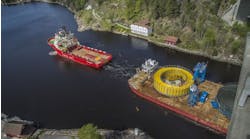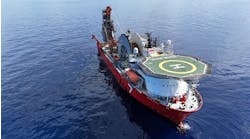Nick Terdre
Contributing Editor
Boa Offshore, the Norwegian towing, barging, heavy-lift and salvage operator, is close to introducing the first of two newbuild deepwater subsea services and construction vessels to the market. The Boa DeepC and Boa DeepC II can also be outfitted for light subsea well intervention.
Boa DeepC was delivered in 2003 and Boa DeepC II in early 2005. Both vessels had their hulls built in China, and both have since been outfitted at the Factorias Vulcano yard in Vigo, northwest Spain.
The vessels will be marketed primarily through a new subsea partnership established by Aker Marine Contractors and Clough Engineering. Boa has an indirect stake in this venture through its 40% ownership of AMC. The two contractors will be looking for work worldwide. With a transit speed of 17 knots, Boa DeepC and Boa DeepC II will be able to move rapidly between different regions.
They will also have access to other vessels in the Boa fleet. These include the recently delivered support vessels Boa King and Boa Queen, whose capabilities include laying anchors in depths down to 1,880 m, and the multipurpose sister ships Boa Hercules and Boa Giant.
Boa DeepC and Boa DeepC II will be capable of installing subsea structures such as templates, trees, and wellheads, and laying reeled pipelines. In addition to their subsea installation function they are designed to meet the DNV Well Intervention Unit class requirements and the relevant rules of the Norwegian petroleum and maritime directorates, and only minor modifications will be required to outfit them for well intervention.
Boa DeepC has a length of 120 m and is equipped with a 250-tonne midship-crane capable of operating down to 2,000 m, and heavy-duty winches with 3,000 m operating capacity. For pipelay purposes, it will be capable of handling up to 2,500 tonnes of net flexible pipe of up to 12-in. diameter. At 140 m, Boa DeepC II will be slightly longer, to give it the capability for rigid pipelay. Its net pipe capacity will be 4,500 tonnes. It will be equipped with a 350-tonne midship crane capable of landing a structure of 290 tonnes in 2,000-m water depth.
In most other respects the vessels are identical. Each has a 20 MW power system, two engine-rooms, and DPIII capability, as well as a 7.2 x 7.2 m moon pool and two ROV systems capable of operating down to 3,000 m.
Boa DeepC has two contracts lined up. The first involves the installation of six subsea templates on Statoil's Snøhvit field in the Barents Sea, with work scheduled to take place in summer 2004. Each template will be towed some 160 km from shore to the field location in mid water, and submerged to a depth of 70-100 m. The largest template will weigh 240 tonnes, with dimensions of 32 x 16 x 12 m.
The second contract is for the installation of the mooring system for Statoil's Kristin semisubmersible production platform. The work, which involves the installation of 16 suction-pile anchors and associated equipment, is also due to take place next summer.
For well intervention work the AMC/Clough joint venture will team up with Kværner Oilfield Products that will supply the wireline lubricator, Maritime Well Services, for wireline equipment and Oil Tool Co. for intervention operations.


